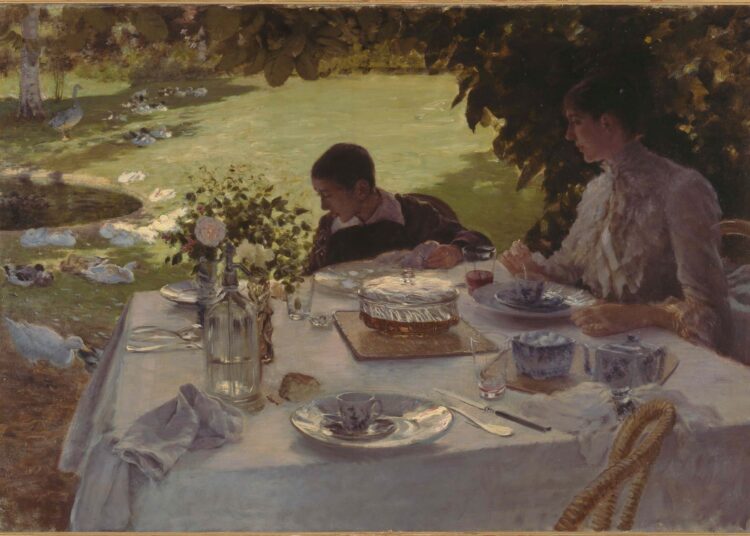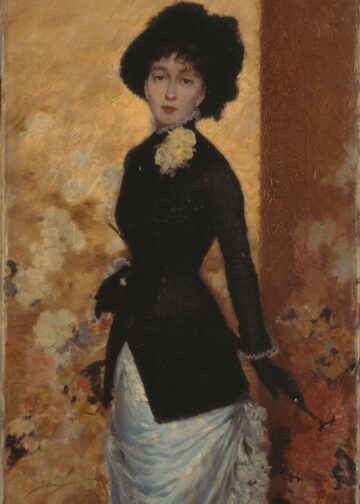In the 19th century Italy was no longer the world center of contemporary painting which thanks to Cezanne, Degas, Manet, Monet, Renoir, Van Gogh and many others, had moved to France, especially to Paris and Provence, as well as to England with Turner’s and Sisley’s masterpieces. Italy’s lone Impressionist of note was Giuseppe De Nittis (1846-84). The distinguished art historian Federico Zeri (1921-98) called him “Italy’s greatest artist of the 19th century” and “Italy’s Sisley, Monet, and Pissarro”.
In spite of Zeri’s heartfelt appreciation of De Nittis, and, although his paintings are displayed in the Met, Chicago’s Art Institute, Boston’s Museum of Fine Arts, Middlebury College’s Art Museum, Washington’s National Gallery of Art, and Philadelphia’s Museum of Art, there has never been a monographic exhibition of his works in the United States until now.

Thanks to the support of the Puglia’s regional Government, from November 12-February 12, 2023, “An Italian Impressionist in Paris: Giuseppe De Nittis”, will be held at the Phillips Collection in Washington D.C.. This location is most appropriate because the Collection is the first modern art museum in the United States and home to one of the world’s most special Impressionist collections.
Also noteworthy is the 250-page catalogue published by the Phillips Collection with support from the Italian Embassy and Cultural Institute in Washington D.C.. It’s the first monograph in English about De Nittis.

Sixty of the 74 works-of-art in the exhibition are by De Nittis. Thirty-two of these, 26 paintings plus a collage, three prints, and two watercolors, are on loan from the Pinacoteca De Nittis in Barletta. These paintings are divided into seven sections, “Atmosphere, Clouds, Stormy Skies, Studies of Light”, “Naples/Vesuvius Degas and De Nittis”, “De Nittis and Caillebotte in Southern Italy, 1872/1875”, “Landscape and Leisure”, “Urban Views-Paris and London”, “The Races: Paris and London” and “Gardens”.
The other De Nittis on display are from 15 museums worldwide including The Metropolitan, The Louvre, The Petit Palais, The Carnavalet Museum also known as the Museum of the History of Paris, Chicago’s Art Institute and Boston’s Museum of Fine Arts as well as 14 paintings in private collections. The additional paintings are by his close friends Degas, Manet and Caillebotte for stylistic comparison.
Unfairly over-shadowed by his many French contemporaries, “this exhibition aims to show that De Nittis was a major figure in the history of modernism and 19th-century European art,” Renato Miracco, the exhibition’s curator, explains in the press release. “This exhibition, created to rediscover the artist and the links between him and his French colleagues, explores his close friendships with Degas, Manet, and Caillebotte, and firmly cements De Nittis as a missing and important piece in understanding Impressionism.”

Born in Barletta on February 25, 1846 Giuseppe De Nittis was the fourth child of Teresa Emanuela Baracchia and Don Raffaele De Nittis, a wealthy landowner and strong supporter of the Unification of Italy, who, recognizing his son’s precocious artistic talent, gladly paid for his painting lessons. After the premature deaths of both his parents (his father committed suicide), De Nittis moved in 1860 to Naples with his siblings. Here his older brother Vincenzo, who, although he believed that “painting was the profession of the desperate”, enrolled Giuseppe at the prestigious Reale Istituto di Belle Arti. Expelled three years later for disciplinary reasons: because he outspokenly judged his teachers too old-fashioned, De Nittis nonetheless launched his artistic career in Naples. He founded with other Neapolitan artists the anti-academic la Scuola della Resina, which approached nature with a new directness. It focused on the effects of changing light and weather conditions, particularly clouds. Thus, like the French Impressionists, De Nittis already preferred to sketch outdoors and complete his work in his studio afterwards.
In 1867, after a whirlwind tour of Italy and a brief stay in Florence, at age 21 De Nittis settled permanently in Paris in 1867 and in 1869 married his Parisian wife Léontine Lucile Gruvelle. Their home soon became a favorite gathering place for Parisian writers: Dumas, De Goncourt and Zolà, and artists like Degas, Manet, and Caillebotte, as well as other expatriate Italians like Boldini. In 1874, a determining date for his future success, his friend and mentor Degas invited De Nittis to participate in the very first Impressionist exhibition; he was the only Italian.

A year later during a long sojourn to London, he dabbled in watercolors and took up pastels, which thereafter remained his favorite medium for painting many views of that city. Once back in Paris De Nittis executed pastel portraits of sitters including De Goncourt, Zolà, Degas, Manet, and Duranty, as well as more oil works of city views and local mundane customs.
His greatest recognitions came in 1878 when he received the Légion d’honneur and he exhibited twelve paintings at the Exposition Universelle where was awarded a gold medal.
On August 21, 1884, at age 38, De Nittis died suddenly of a stroke and respiratory problems probably due to exhaustion from overworking at Saint-Germain-en-Laye on the outskirts of Paris. He’s buried in the monumental Cimetière du Père-Lachaise. Soon afterwards Gauguin wrote: “Everyone is copying De Nittis…He reached perfection in the style begun by the Impressionists”.
His wife, who was often his model, in 1913 bequeathed 146 paintings, 65 drawings, plus more than 150 books and archival documents, to his birthplace Barletta. After years of neglect and several temporary locations, since 2007 they’re housed in the Pinacoteca De Nittis located in the elegant Baroque Palazzo della Marra. In 2019 its curator Renato Miracco created its state-of-the-art installation.
Elsewhere in Italy De Nittis’ artworks belong to museums and private collections in Bari, Florence, Genova, Naples, Pavia, Pescara, Pisa, Rome, Rovigo, Trieste, Turin. Outside Italy in Europe they’re displayed in The British Museum, The National Gallery in London, the Musée D’Orsay, the Petit Palais and the Carnavalet Museum, Amsterdam’s Stedelijk Museum, and Turku’s Turun Taidemuseo.
As of now there are no definite future travel plans, but, because De Nittis, like many of his French Impressionist colleagues, loved Japanese art, several museums in Japan hope to host “An Italian Impressionist in Paris: Giuseppe De Nittis”.











